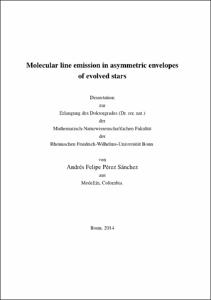Pérez Sánchez, Andrés Felipe: Molecular line emission in asymmetric envelopes of evolved stars. - Bonn, 2014. - Dissertation, Rheinische Friedrich-Wilhelms-Universität Bonn.
Online-Ausgabe in bonndoc: https://nbn-resolving.org/urn:nbn:de:hbz:5n-36745
Online-Ausgabe in bonndoc: https://nbn-resolving.org/urn:nbn:de:hbz:5n-36745
@phdthesis{handle:20.500.11811/6125,
urn: https://nbn-resolving.org/urn:nbn:de:hbz:5n-36745,
author = {{Andrés Felipe Pérez Sánchez}},
title = {Molecular line emission in asymmetric envelopes of evolved stars},
school = {Rheinische Friedrich-Wilhelms-Universität Bonn},
year = 2014,
month = jul,
note = {Stars with initial masses of 0.8 < M⋆ < 9M⊙ eject most of their mass when evolving along the asymptotic giant branch (AGB) phase. The ejected material eventually cools down, which leads it to condensate and to form dust grains and molecular gas around the star, creating an extended circumstellar envelope (CSE). The mechanism responsible for the expansion of the dusty and dense CSEs is not completely understood. It is suggested that stellar radiation pressure on the dust particles can accelerate them outwards. Then, by collisional exchange of momentum, the dust particles drag along the molecular gas. However, this scenario cannot explain the onset of asymmetries in the CSEs observed towards more evolved sources such as post-AGB sources and Planetary nebulae.
Part of the research in this thesis is focused on the study of the role that the stellar magnetic field plays on the formation of the collimated high-velocity outflows observed towards post-AGB sources. Polarized maser emission towards (post-)AGB stars has become an useful tool to determine the properties of the stellar magnetic fields permeating their CSEs. However, the polarization fraction detected can be affected by non-Zeeman effects. Here I present the results of our analysis of the polarization properties of SiO, H2O and HCN maser emission in the (sub-)millimetre wavelength range. The goal of this analysis is to determine whether polarized maser emission of these molecular species can be used as reliable tracer of the magnetic field from observations at (sub-)millimetre wavelengths.
I also present the results of radio interferometric observations of both continuum and polarized maser emission towards post-AGB stars. The sources observed are characterized by H2O maser emission arising from their collimated, high-velocity outflows. The observations have been carried out with the Australian Telescope Compact Array aiming to detect both polarized maser emission and non-thermal radio continuum emission.
Part of the research on this thesis is dedicated to radiative transfer modelling of CO emission towards asymmetric AGB sources. Radio observations of CO emission are commonly used to probe the mass loss rates and the kinematics of the CSEs. However, in most cases the observed sources are assumed spherically symmetric. Here I present the results of simulated observations towards oblate CSEs. The aim of this study is to identify the effects induced by the asymmetries on the observed spectral features, and consequently, on the physical parameters of the CSEs derived assuming the sources spherically symmetric.},
url = {https://hdl.handle.net/20.500.11811/6125}
}
urn: https://nbn-resolving.org/urn:nbn:de:hbz:5n-36745,
author = {{Andrés Felipe Pérez Sánchez}},
title = {Molecular line emission in asymmetric envelopes of evolved stars},
school = {Rheinische Friedrich-Wilhelms-Universität Bonn},
year = 2014,
month = jul,
note = {Stars with initial masses of 0.8 < M⋆ < 9M⊙ eject most of their mass when evolving along the asymptotic giant branch (AGB) phase. The ejected material eventually cools down, which leads it to condensate and to form dust grains and molecular gas around the star, creating an extended circumstellar envelope (CSE). The mechanism responsible for the expansion of the dusty and dense CSEs is not completely understood. It is suggested that stellar radiation pressure on the dust particles can accelerate them outwards. Then, by collisional exchange of momentum, the dust particles drag along the molecular gas. However, this scenario cannot explain the onset of asymmetries in the CSEs observed towards more evolved sources such as post-AGB sources and Planetary nebulae.
Part of the research in this thesis is focused on the study of the role that the stellar magnetic field plays on the formation of the collimated high-velocity outflows observed towards post-AGB sources. Polarized maser emission towards (post-)AGB stars has become an useful tool to determine the properties of the stellar magnetic fields permeating their CSEs. However, the polarization fraction detected can be affected by non-Zeeman effects. Here I present the results of our analysis of the polarization properties of SiO, H2O and HCN maser emission in the (sub-)millimetre wavelength range. The goal of this analysis is to determine whether polarized maser emission of these molecular species can be used as reliable tracer of the magnetic field from observations at (sub-)millimetre wavelengths.
I also present the results of radio interferometric observations of both continuum and polarized maser emission towards post-AGB stars. The sources observed are characterized by H2O maser emission arising from their collimated, high-velocity outflows. The observations have been carried out with the Australian Telescope Compact Array aiming to detect both polarized maser emission and non-thermal radio continuum emission.
Part of the research on this thesis is dedicated to radiative transfer modelling of CO emission towards asymmetric AGB sources. Radio observations of CO emission are commonly used to probe the mass loss rates and the kinematics of the CSEs. However, in most cases the observed sources are assumed spherically symmetric. Here I present the results of simulated observations towards oblate CSEs. The aim of this study is to identify the effects induced by the asymmetries on the observed spectral features, and consequently, on the physical parameters of the CSEs derived assuming the sources spherically symmetric.},
url = {https://hdl.handle.net/20.500.11811/6125}
}






